|
Gary Gregg - Painter
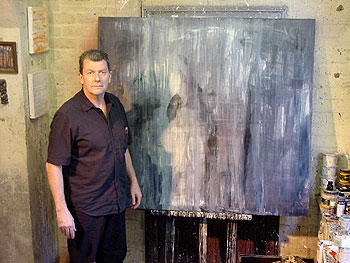
Gary Gregg in residence in Lloyd Ree's studio with work in progress.
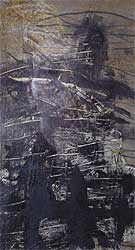 Gary Gregg: Painter, Barrister, Artist in Residence in Lloyd Rees' studio, father of five, doting husband. Gregg's work has been composed over the last year. It began on retreat in Rome and Lucca, Italy and finished in the Booderee National Park, south of Sydney. Gary Gregg: Painter, Barrister, Artist in Residence in Lloyd Rees' studio, father of five, doting husband. Gregg's work has been composed over the last year. It began on retreat in Rome and Lucca, Italy and finished in the Booderee National Park, south of Sydney.
His life is solid, work ethic: strong; focus: rigorous and committed to excellence in everything he does. Gregg is a person who has realised the satisfaction in immersing oneself in tasks which involve taking risks and finding a way to bring the work to fruition.
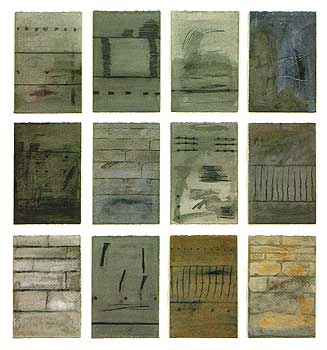 In Lucca Gregg produced many drawings that have been culled to a series of twelve, 30 x 20 cm panels executed in payne's grey acrylic, black compressed charcoal, black and sepia ink wash and gold oxide. They have been drawn, scumbled, scraped and washed to leave compositions that are both literal and abstract. Some panels are large, flat, ancient brick walls or balcony railings, while others are marks out of his head. In Lucca Gregg produced many drawings that have been culled to a series of twelve, 30 x 20 cm panels executed in payne's grey acrylic, black compressed charcoal, black and sepia ink wash and gold oxide. They have been drawn, scumbled, scraped and washed to leave compositions that are both literal and abstract. Some panels are large, flat, ancient brick walls or balcony railings, while others are marks out of his head.
In hindsight, Gregg knew he was immersed in his work when he reflects on saying no to an invitation to visit Florence for the day. His, "very patient wife" had to go alone, though speaking fluent Italian of course she had a great day without him. Gregg drew and drew and continued with a series of work that imbues sitting in the Colosseum, the holes in the marble walls of the forum, the age of the buildings, just being in the landscape. His time in Italy, this time, was about walking 10 km a day, in any direction and taking it all in. This time, it all came out on paper.
Gregg was very much in drawing mode in Italy. He makes a distinction between drawing and painting. Self taught and with a day job Gregg configures the two mediums in terms of modes. He reflects that while he can draw when he is in a painting mode, really good drawing can only be done when he is not painting. He finds that he is moved to either paint or draw at any one time and that it is better to immerse oneself in either the painting or drawing process to achieve the best results. "Drawing informs painting, but drawing and painting come from different places."
Gregg didn't always consider himself to be a drawer. It was Channy Coventry who turned him onto how important drawing is. Coventry was not one to say much about an artist's work. If Channy said, "I don't mind that", or, "That's not bad", that was high praise indeed. Gregg drew little before his first encounter with Coventry. Gregg had begun exhibiting with Crawford Gallery when they were on Liverpool Street in East Sydney. In 1997 he went to Coventry to see if he'd take him on. Coventry looked at a selection of paintings and then stated flatly, "I'm not making any decisions about you until I see your drawings." Gregg at this point was thinking, "What drawings?" But the old man insisted that Gregg go away and draw. He wanted to see everything that Gregg drew, including the mistakes and insisted, "Don't cull them!" So Gregg went away for a couple of months and drew. Fifty, then sixty drawings later he went back. Gregg had gone through the portfolio and almost taken a few unsuccessful efforts out but then thought better of it.
Gregg opened the portfolio and started flipping the drawings over one by one and Coventry sat mute. By the 50th drawing, Coventry had not said a word. "I thought he hated them," but Gregg kept turning the drawings. At number 52 the old man said, "Put that one over there." and he did. At number 57 he said, "That one with the other." He had selected two out of sixty. "Go back to the start." Coventry looked through the drawings three times and at the end had a small pile of a dozen works set aside. He said to Bryan Hooper, "What do you think Bryan? Will these do for Tuesday?" Gregg was still feeling bewildered and seeing this Bryan asked the leading question, "You mean for the Diary Show?" (- a taster for the year's exhibitions to come.) Gregg had three drawings and a painting in the Diary Show which opened a few days later and followed with successful solo exhibitions at Coventry in 1998 and 1999. Gregg now exhibits with Bryan Hooper at the BBA Gallery. A year after the ordeal Coventry explained, "If you'd culled them I wouldn't have touched you." He could get inside the head of the artist through their mistakes. It was imperative that he be able to see both the failures and the origins of ideas that were worked out more successfully in later pieces.
In 2001 Gregg spent a lot of time sketching in Rome and took many photos. He has never drawn from a photo in any literal way but often uses them to get back into the feeling of a place. He also sits in the landscape and draws and has begun to go back to Stoney Creek in Booderee National Park at Jervis Bay for this purpose, he just loves being there. Again Leura has held the same sway in his choice of places to draw. The escarpement and a crude fire trail informed a successful configuration of stick-like lines which has lead to a series of large mixed media works that depict the impact of the juxtaposition of the manmade, bulldozed area through the otherwise pristine bush.
Gregg favours compressed charcoals, both German Pitt rods and squared sticks that leave a clean fine edge from the new end and broad marks from worn parts.
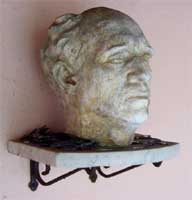 Whose studio would you want to paint in? Lloyd Ree's: located under the house the great man designed in the 1930s in Northwood. Rees purchased the land for 500 pounds. The house is based on a Tuscan idea, radical for its day and is painted a shell pink with turquoise gates today. The studio still contains many artefacts from Lloyd's presence. Brushes in containers on the window ledge, shelves full of bottles and tins of oils and paints, ginger jars and clothes behind the door. Gregg just works around them. There's a bust in the front entryway that one must walk past to enter the studio. You can't help but think of Rees as the host as you enter. When Alan and Jan Rees first offered Gregg the use of the studio, he warned that he was very messy and was told in response not to worry, so was the last bloke. Gregg is the first artist apart from Rees to use the studio. Alan and Jan are glad that a working artist is using the studio and to smell paint in the place again. Whose studio would you want to paint in? Lloyd Ree's: located under the house the great man designed in the 1930s in Northwood. Rees purchased the land for 500 pounds. The house is based on a Tuscan idea, radical for its day and is painted a shell pink with turquoise gates today. The studio still contains many artefacts from Lloyd's presence. Brushes in containers on the window ledge, shelves full of bottles and tins of oils and paints, ginger jars and clothes behind the door. Gregg just works around them. There's a bust in the front entryway that one must walk past to enter the studio. You can't help but think of Rees as the host as you enter. When Alan and Jan Rees first offered Gregg the use of the studio, he warned that he was very messy and was told in response not to worry, so was the last bloke. Gregg is the first artist apart from Rees to use the studio. Alan and Jan are glad that a working artist is using the studio and to smell paint in the place again. |
Lloyd was part of the Northwood Group. It was like a sketch club that included John Santry, Roland Wakelin and George Lawrence. Whiteley used to come along sometimes and sketch in the evenings that they met at Santry's house to draw. It's a great tradition to step into and participate in through exposure to the places and works of these formidable talents. Layers of washes and marks and uninhibited exploration of the painted surface seem to tie Gregg firmly to the influence of these local painters. Gregg's work obscures the landscape, which he sometimes uses as a starting point, rather than the end point in a composition.
|
Gregg explains that when he paints what happens is you try to, "resolve the dialogue between yourself and the idea in the surface of the work."
He went on to describe his process, not as a problem solving exercise or the act of depicting something but as a means of expressing the dialogue between the idea at hand and the material. The working surface is where the idea is worked out.
Gregg sometimes works to music, Neil Young and the ilk, but he doesn't get stuck on a track like some artists. His wellspring of creative energy comes from creating itself. However, "Making art isn't something you can do any time, anywhere, on all occasions. If you're tired or stressed it's not going to happen." Gregg does occasionally run out of creative energy but on the other hand if he is denied time to paint he can fell frustrated like a jogger not getting their daily fix of adrenalin. Painting is a part of his way of being-in-the-world. It isn't a hobby but as he describes it, "an obsession".
Gregg is a barrister by day where, like his work as an artist, he relies on his own resources. It's something he loves being. He enjoys the dynamics and being put on the spot, having the whole course of a trial rest on your research and your competence in bringing it together. There is an element of risk taking common to both fields of expertise, you stand alone to argue your case, there is nowhere to hide. Similarly when you make a mark on a white canvas or paper, you are exposed by your risk taking.
|
|
It's like the old adage, "Nothing ventured, nothing gained," if one doesn't make the first mark. Neither professions are safe options and at the height of his powers he is gaining enormously by taking great risks.
Beginning a painting is also a risk, as Gregg never really knows where he is going with a work when he starts out. He ventured into painting without a teacher, without guidance and has been developing his own way, his own techniques through his body of completed works. "You learn when to pull back, when to make a mark, when to let it breathe, when to leave a space", how to achieve a balance and to stop.
It's the idea of being someone who never makes a mark and rather builds themselves a risk free world that is anathema to Gregg. "To be a painter you have to be prepared to be exposed, to be prepared for criticism. Like standing in court, it's pretty obvious pretty quickly if you haven't prepared your case. Of course Gregg enacts a work ethic. "Whatever I do, I do as well as I can." But still he risks committing marks to canvas and following the lead of a long bristled brush into a kind of calligraphic technique that is new.
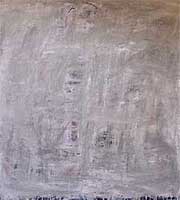 | 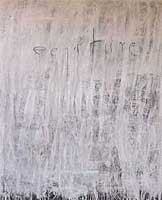 | 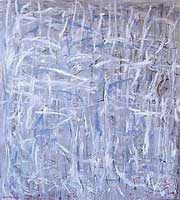 | | Ecriture #1 | Ecriture #2 | Ecriture #3 |
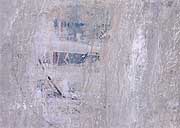 | 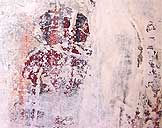 | 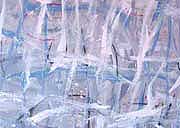 |
Gregg has discovered a new brush that has long bristles and consequently a new movement in the wrist, a freer style which has led to the beginning of a new series, "ecriture". Three large canvases have been finished. The second features the word ecriture scumbled in charcoal which did in fact solve a composition problem of a large, relatively flat area. The word "ecriture" bleeds into vertical marks that predominate throughout Gregg's work. It is also used in the third work in a way that breaks down the word to component parts that stand alone as shapes and imagery rather then text. What, if anything, was being said, has been lost under the white and bright blue paint. The dominant marks are long like a drawn line, like a written letter and are thatched across the canvas in a nice loose overlayer. The letters become marks.
As Gregg says, "I'm a figure and ground painter." He always underpaints. This series is tied to the last in that the layers recede. There are glimpses of underlayer invoking puzzlement or at least a prolonged gaze.
In his previous work Gregg stopped fighting the landscape and allowed it to come through. This work includes "In the half light" a work hung in the 1999 Wynne Prize. This piece conveyed a giddy sense of perspective with warm, grey, wide marks at the top of the picture that brought the far near. The "Kensho" ("to see nature, to see into essential nature") Series culminated in a yellow wooded landscape that borrows from conventional perspective. It uses half and quartertones, nothing straight form the tube, only colours that are mixed on the surface.
Gregg's dining room has looked like Robert Klippel's house for a while now. It's covered in drawings in the lead up to the BBA Show. Friend Rob Schumacher recently remarked, "Ah, you've got your chops up!" (Referring to a trumpeter's practiced lips that result form hours of hard work). Other artists talk about when they were fit and working at their best. Gregg's friend Stephen Coburn refers to the quality of the marks he was making when he was in his best physical condition as his best work. So too wobbly and unsteady lines are symptomatic of "bad art". Gary Gregg has spent some time "getting in nick", discarding drawings, culling, leaving the best.
The resulting works hung at the BBA Gallery include abstracted sand dunes featuring largely symbolic vegetation. The material is inky glazed sepia and compressed charcoal on paper often combined with a lilac grey produced from Indian ink and white powered pigment in the smaller works. The overall effect is one of space in balance with drawn areas informed by texture and realised depth.
Interview with Jayne Waterford
8 September 2002
|